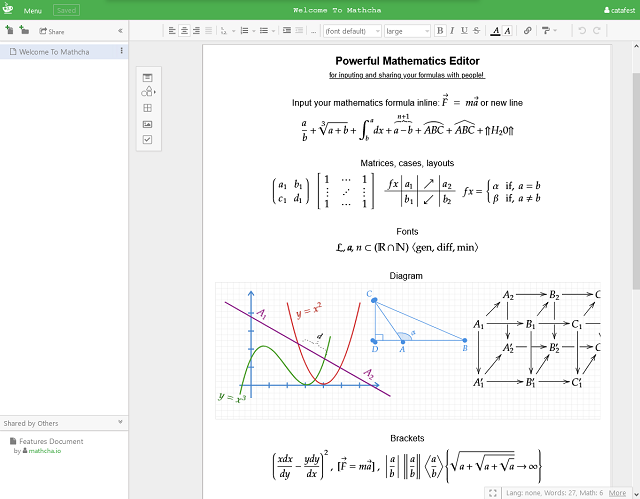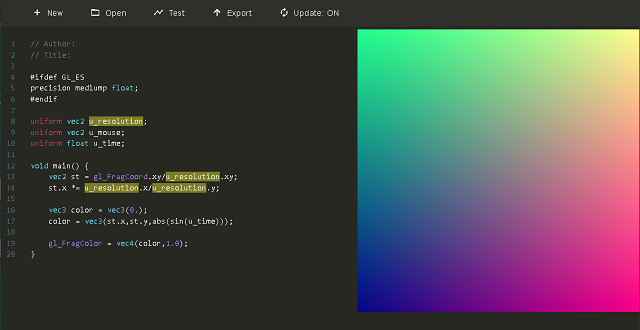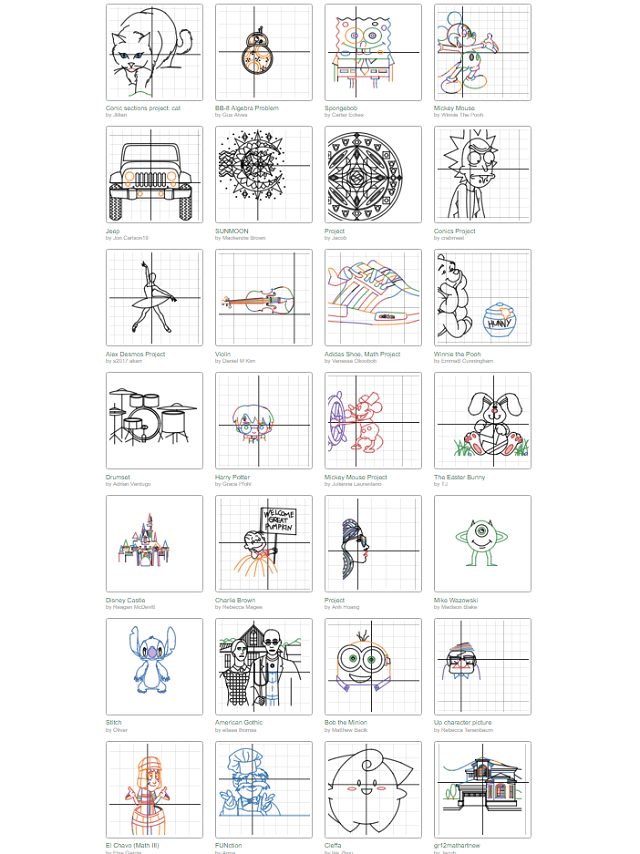... one good youtube channel using clear, intuitive examples about artificial intelligence and more, DataMListic - the official youtube channel.
2D, 3D, game, games, online game, game development, game engine, programming, OpenGL, Open AI, math, graphics, design, graphic, graphics, game development, game engine, programming, web development, web art, web graphic, arts, tutorial, tutorials,
Se afișează postările cu eticheta mathematical functions. Afișați toate postările
Se afișează postările cu eticheta mathematical functions. Afișați toate postările
sâmbătă, 15 noiembrie 2025
sâmbătă, 17 iunie 2023
duminică, 28 mai 2023
Sounds of Math Graphs by oynozan ...
Posted by
Cătălin George Feștilă
 Labels:
2023,
2023 news,
2D,
design,
graphics,
math,
mathematical functions,
news
Labels:
2023,
2023 news,
2D,
design,
graphics,
math,
mathematical functions,
news
luni, 11 aprilie 2022
Painting a Landscape using Mathematics by Inigo Quilez.
Inigo Quilez is a software engineer, technical artists, product manager and educator for 20 years, and have worked at places like Pixar and Oculus.
You can see the real-time rendering code on this webpage.
This is a video tutorial about how can build landscape using the mathematics:
Posted by
Cătălin George Feștilă
 Labels:
2022,
Inigo Quilez,
math,
mathematical functions,
shader,
shadertoy,
tutorial,
tutorials,
video tutorial
Labels:
2022,
Inigo Quilez,
math,
mathematical functions,
shader,
shadertoy,
tutorial,
tutorials,
video tutorial
luni, 1 februarie 2021
Shadertoy: Modulo N and shader effects.
You can see easily how the math function modulo n affects the shaders.
These three colors are the result of the function modulo n.
You can see two vectors with two modulo ivec areas with these values: 6 and 3.
You can make changes and you see similar results.
A good math teacher can explain why this is happening.
Let me give you a hint: encryption and decryption theories.
Posted by
Cătălin George Feștilă
 Labels:
2021,
2D,
graphic,
graphics,
math,
mathematical functions,
programming,
shader,
shadertoy,
source code,
tutorial,
tutorials
Labels:
2021,
2D,
graphic,
graphics,
math,
mathematical functions,
programming,
shader,
shadertoy,
source code,
tutorial,
tutorials
miercuri, 15 iulie 2020
Another online math editor named mathcha.
If you like math whether you are a student, teacher, or parent, then this online editor is very suitable for you.
Take a look at the official youtube channel:

Take a look at the official youtube channel:

Posted by
Cătălin George Feștilă
 Labels:
2020,
2D,
editor,
graphics,
math,
mathematical functions,
online,
online tool,
web,
website
Labels:
2020,
2D,
editor,
graphics,
math,
mathematical functions,
online,
online tool,
web,
website
vineri, 24 mai 2019
GridMaths online tool to start with math.
This online tool named GridMaths for math can be used here.
The tool can be used for kids and parents or can use into advanced math.
I author comes with a series of articles about this online tool, see this link.
One good example about how can use this online tool can be found on youtube:
The tool can be used for kids and parents or can use into advanced math.
I author comes with a series of articles about this online tool, see this link.
One good example about how can use this online tool can be found on youtube:
Posted by
Cătălin George Feștilă
 Labels:
2019,
GridMaths,
math,
mathematical functions,
online tool,
tutorial,
tutorials,
video tutorial
Labels:
2019,
GridMaths,
math,
mathematical functions,
online tool,
tutorial,
tutorials,
video tutorial
vineri, 8 martie 2019
Heart shapes with Wolfram MathWorld.
I chose to present this resource today because it is March 8th.
There are a number of mathematical curves that produced heart shapes and you can find many tools on the web.
The author presents himself with a brief introduction:
Eric W. Weisstein began compiling scientific encyclopedias as a high school student nearly twenty years ago. Born in Bloomington, Indiana in 1969, Weisstein studied physics and astronomy at Cornell University and Caltech and received his Ph.D. from Caltech in 1996. In 1995, Weisstein took the vast collection of mathematical facts that he had been accumulating since his teenage years and began to deploy them on the early internet. These pioneering efforts at organizing and presenting online content helped define a paradigm that has subsequently been followed by other large-scale informational projects on the web.
The most important part of this resource is highlighted in a table of contents about mathematical issues:
If you want to use the Wolfram Alpha syntax, there are formulas:
There are a number of mathematical curves that produced heart shapes and you can find many tools on the web.
The author presents himself with a brief introduction:
Eric W. Weisstein began compiling scientific encyclopedias as a high school student nearly twenty years ago. Born in Bloomington, Indiana in 1969, Weisstein studied physics and astronomy at Cornell University and Caltech and received his Ph.D. from Caltech in 1996. In 1995, Weisstein took the vast collection of mathematical facts that he had been accumulating since his teenage years and began to deploy them on the early internet. These pioneering efforts at organizing and presenting online content helped define a paradigm that has subsequently been followed by other large-scale informational projects on the web.
The most important part of this resource is highlighted in a table of contents about mathematical issues:
- Algebra
- Applied Mathematics
- Calculus and Analysis
- Discrete Mathematics
- Foundations of Mathematics
- Geometry
- History and Terminology
- Number Theory
- Probability and Statistics
- Recreational Mathematics
- Topology
If you want to use the Wolfram Alpha syntax, there are formulas:
heart curve
Posted by
Cătălin George Feștilă
 Labels:
2019,
2D,
3D,
mathematical functions,
online tool,
software,
web development
Labels:
2019,
2D,
3D,
mathematical functions,
online tool,
software,
web development
marți, 20 februarie 2018
Online book: The Book of Shaders .
This online book named The Book of Shaders by Patricio Gonzalez Vivo and Jen Lowe is a good start to learn and test shaders.
The authors tell us:
Getting started
What is a fragment shader?
In the previous chapter we described shaders as the equivalent of the Gutenberg press for graphics. Why? And more importantly: what's a shader?
If you already have experience making drawings with computers, you know that in that process you draw a circle, then a rectangle, a line, some triangles until you compose the image you want. That process is very similar to writing a letter or a book by hand - it is a set of instructions that do one task after another.
Shaders are also a set of instructions, but the instructions are executed all at once for every single pixel on the screen. That means the code you write has to behave differently depending on the position of the pixel on the screen. Like a type press, your program will work as a function that receives a position and returns a color, and when it's compiled it will run extraordinarily fast.
Why are shaders fast?
To answer this, I present the wonders of parallel processing.
Imagine the CPU of your computer as a big industrial pipe, and every task as something that passes through it - like a factory line. Some tasks are bigger than others, which means they require more time and energy to deal with. We say they require more processing power. Because of the architecture of computers the jobs are forced to run in a series; each job has to be finished one at a time. Modern computers usually have groups of four processors that work like these pipes, completing tasks one after another to keeping things running smoothly. Each pipe is also known as a thread.
Video games and other graphic applications require a lot more processing power than other programs. Because of their graphic content they have to do huge numbers of pixel-by-pixel operations. Every single pixel on the screen needs to be computed, and in 3D games geometries and perspectives need to be calculated as well.
You can test online the shader editor on this webpage.

Posted by
Cătălin George Feștilă
 Labels:
2018,
mathematical functions,
shader,
tutorial,
tutorials,
web development,
website
Labels:
2018,
mathematical functions,
shader,
tutorial,
tutorials,
web development,
website
miercuri, 26 iulie 2017
The art of mathematical functions.
If you want to see something special about math and art, then there is such a website.
Here are some funny examples of math functions in the following screenshot:
Here are some funny examples of math functions in the following screenshot:

Abonați-vă la:
Comentarii (Atom)
